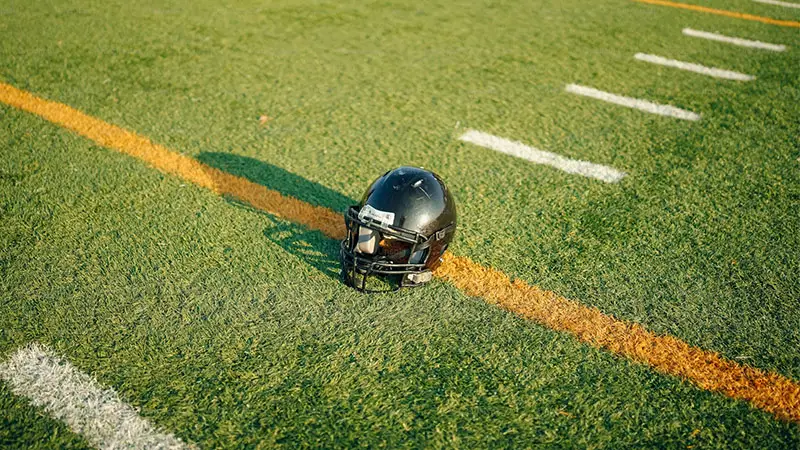If you’ve ever watched an American football game, you’ve probably marveled at the yellow first-down line that magically appears on your screen.
This seemingly simple feature has revolutionized the viewing experience, providing fans with real-time clarity on game progress. But how does this digital marvel actually work?
The technology behind the yellow first-down line is far from simple. It emerged from the ashes of the much-criticized FoxTrax system used in hockey during the mid-90s.
Debuting in 1997, the First-and-Ten Yellow Line stunned viewers and sports journalists alike with its precision and seamless integration into live broadcasts.
This groundbreaking innovation relies on sophisticated modeling, real-time image processing, and a team of engineers from various fields, transforming the way we watch football forever.
Evolution of the First Down Line
The first down line has transformed American football broadcasts. This section explores its origins and the technological advancements over the years.
Origins and Historical Context
The first down line idea dates back to the mid-90s. Inspired by the FoxTrax hockey puck system, Sportvision brought the concept to Jed Drake at ESPN.
As the head of Event Production, Drake saw potential but needed NFL approval. After showing a demo tape, NFL executives endorsed the idea with one condition: the first down line couldn’t be used during replays.
In 1998, ESPN gave the concept new life, with programmer Gary Morgenstern and coordinating producer Fred Gaudelli overseeing the implementation. The first broadcast occurred on September 27, 1998, during a Cincinnati Bengals vs. Baltimore Ravens game on ESPN.
Technological Advancements Over the Years
Creating the first down line required significant technology, including four SGI computers, one PC, three special computers, and various sensors managing the broadcast cameras.
Technicians developed a digital 3D model of the field to link each pixel on the TV screen to an exact field location. By Thanksgiving Day in 1998, competing solutions like PVI’s version on CBS further advanced the technology.
Four years later, SportsMEDIA introduced another version during NBC’s coverage of a Notre Dame game, showcasing the ongoing evolution of this crucial football broadcasting tool.
How the First Down Line Works
The first down line, a staple in modern football broadcasts, involves complex technology that seamlessly integrates with live video feeds.
The Technology Explained
Generating the virtual first down line requires multiple computers, sensors, and software applications. Sportvision’s system uses eight computers: four SGIs, three data acquisition units, and one PC.
These devices create 3D models of the field, ensuring that the line follows the grass’s curves accurately. Special encoders placed around the field capture real-time data, feeding it into the system to maintain line precision.
Additionally, the software recognizes players, referees, and the ball, ensuring the line doesn’t obscure any vital elements during gameplay.
Real-time Application in Broadcasts
In real-time broadcasts, the system adapts dynamically to various camera angles, ensuring the first down line appears consistently from multiple perspectives within the stadium.
As many games utilize numerous cameras to capture action from various points, the system recalibrates continuously. When players or officials cross the line, it adjusts accordingly, preventing overlay disruptions.
Broadcasters can also layer additional graphics without interfering with the first down line, enhancing the viewing experience without compromising the line’s visibility.
Impact on the Game and Viewing Experience
The introduction of the virtual first-down line has revolutionized how fans watch and understand American football. This innovation has not only aided viewers in comprehending game dynamics but also influenced strategic decisions on the field.
Enhancing Viewer Understanding
The virtual first-down line provides a visual marker on the screen, helping viewers unfamiliar with football’s rules understand the game better. It shows the distance needed for a first down, making it easier to grasp the current play, especially during critical third-down scenarios.
This technology offers an instant understanding of whether a play has succeeded, enhancing the accessibility and enjoyment of the game for casual fans. According to ESPN, 94% of viewers found this technology helpful in better understanding the game.
Influences on Game Strategies
The first-down line on television indirectly influences game strategies by making field positioning clearer to fans, prompting coaches and players to possibly adopt more aggressive play-calling on crucial downs.
This visibility also increases the perceived pressure on referees, whose decisions are scrutinized against the obvious marker.
While the line is omitted in replays to prevent second-guessing of officiating, its live presence fosters a transparent and engaging viewing experience, aligning fan perspectives with on-field realities.
Frequently Asked Questions
Can NFL players see the first down line?
The line is not physically present on the field and is seen only by the television audience.
What is the 1st down line in NFL?
The first down line is a computer-generated line that appears on TV broadcasts to represent the spot the offense must reach to achieve a first down.
What is 3rd down in football?
The third down is the third play in a series of four downs, primarily used to attempt to gain the remaining yards needed for a first down.
What does 1st and 2nd down mean in football?
‘1st and 10’ means it’s the first down with 10 yards to go. If a team gains three yards, it becomes ‘2nd and 7’, and continues similarly.
How is the first down line determined?
The first down line is generated using complex computer systems that take into account the camera angles and field dimensions to ensure accuracy on TV.
Conclusion
The virtual first-down line has revolutionized how fans experience American football. From its inception in the mid-90s to its widespread adoption, this technology has become indispensable for viewers and players alike.
By offering a clear visual cue, it enhances understanding and engagement, making the game more accessible. The first-down line’s influence extends beyond the screen, subtly shaping strategies and decisions on the field.
As technology continues to evolve, its role in football broadcasts will likely grow, further enriching the viewer experience and maintaining its status as a game-changing innovation.
Moreover, advancements like augmented reality may soon allow fans to interact with the first-down line through mobile apps, possibly providing real-time stats and insights.
This integration ensures that as technology progresses, football will continue to blend tradition with innovation, keeping audiences captivated and engaged.








Ashley Hopkinson